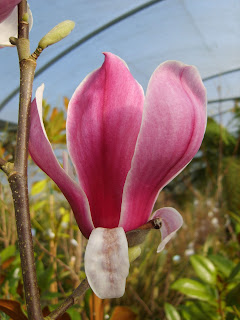When it comes to splendour of spring
the Magnolia is king. Large gardens in the South West boast dozens of
these magnificent trees, some early collections of Magnolia species
are now around 100ft tall and in March and April their blooms stand
out for miles around!
 |
| Magnolia stellata |
As time has passed Magnolia growing has
moved on, and now you can buy some Magnolias in your local garden
centre, although visiting a specialist for something special is very
much worthwhile. Selection of clones, new propagation methods and
good plant breeding have made Magnolias far more accessible to the
general market, although Magnolias are still not cheap- they are not
easy to graft and take a lot of time to make a plant good enough for
sale, so it's unlikely that you will get a good Magnolia for
less than £20, and even then it will be fairly small. Price isn't
all that much of an issue really; most gardens will only have room
for one or two of these trees, so it's a matter of finding the right
tree for your budget.
In a previous blog post I mentioned the
time-scales involved in breeding Camellias and how that affects their
price and makes raising new varieties unattractive to nurseries.
Magnolias have the same problem, but much worse! By the time a
breeder's Magnolia hybrids are flowering in a stock field 20+ years
may have passed since the cross was made and the seeds were sown.
Once a new variety is selected from these seedlings (and indeed if
a seedling is good enough to select) material must be taken and
grafted onto rootstocks to create more propagation material. This
process must be repeated for many years; each grafted plant will have
to be grown for several years until it is big enough to yield more
material for grafting. In order to yield enough material to make
enough plants for release onto the market these plants must be grown
on and on... Magnolia breeding needs time, space and patience!
Gardeners benefit well from this
mammoth breeding task- modern hybrids are often superb, with
excellent colour, form and flowering. Some varieties are well known,
like Magnolia 'Susan' with it's deep purple flowers, and M. 'Star
Wars' with it's open flowers and slightly pointed petals.
 |
| Magnolia 'Susan' in bud |
 |
| Magnolia 'Star Wars' |
 |
| Magnolia 'Iolanthe' |
Some selections are superb for creating
'flower power', such as M. x loebneri 'Merrill', a very good
alternative for Magnolia stellata (top).
Magnolia x loebneri 'Merrill'
For sheer beauty M. x soulangiana
'Picture' is awesome, as are some of the yellow Magnolia hybrids,
like M. 'Elizabeth'.
 |
| M. 'Picture' |
 |
| M. 'Elizabeth' |
If you are making an investment in a
Magnolia you must be sure that you can accommodate it. Soil
requirements are simple but important; a continually moist but
free-draining (NEVER waterlogged) slightly acidic soil is vital.
Magnolias will take plenty of sun anywhere with reliably moist soil
(this is why they do so well in the west of the UK!), but will
tolerate some light shade without any ill effects. Because their
flowers and leaves are fairly large Magnolias are best in a spot
sheltered from the wind. Also, as they are early flowering plants
frost can be an issue- try to site your plant in a spot sheltered
from frosts, but also choose the right variety- blooms of a white
Magnolia will be visibly damaged by even a light frost, so if in
doubt go for a variety with darker flowers so that only damage from
hard frosts will be noticeable.
The next important requirement is
space, and this is why you must choose your Magnolia carefully and if
possible have a good in-depth conversation with a specialist Magnolia
grower; some Magnolias have an upright habit (such as M. 'Star Wars')
but others are more spreading (such as M. stellata). Make no mistake-
you are buying a tree, so it's important to make sure that you have
space to fit a Magnolia as well as a Magnolia suitable for the space.
On the whole the yellow flowered Magnolias seem determined to make a
tree with a straight leader- pruning is very much inadvisable. Your
budget will also play a part in your decision... some Magnolias are
easier to propagate and grow, so will be available as small plants
fairly cheaply (M. stellata is a good example, and M. x loebneri
'Merrill' can be fairly inexpensive) and will flower well as young
plants, but some plants are difficult to grow and are naturally more
tree-like in habit, so will only be available as larger plants with a
larger price tag. It is important to get the right variety- if your
heart is set on a large flowered tree then you must save up!


No comments:
Post a Comment